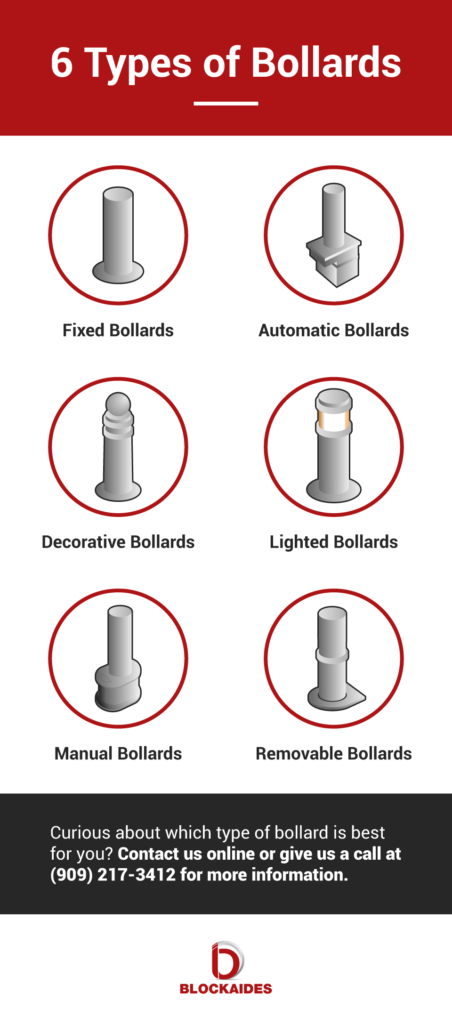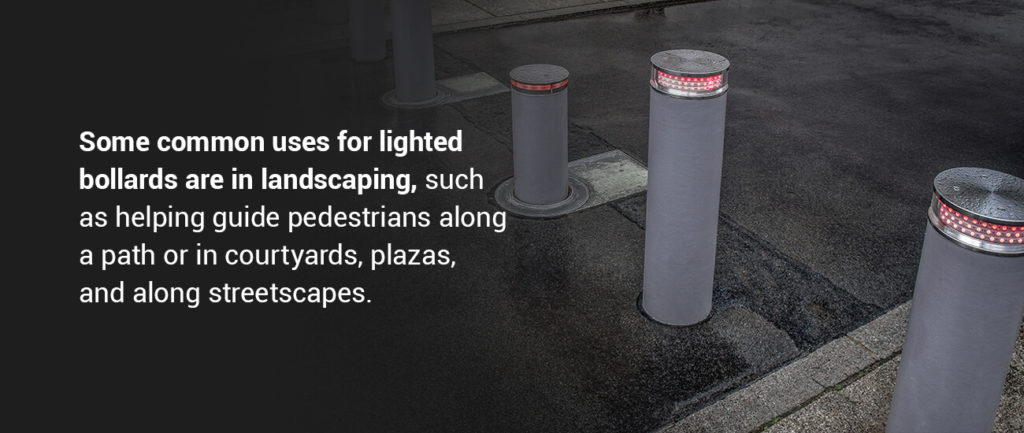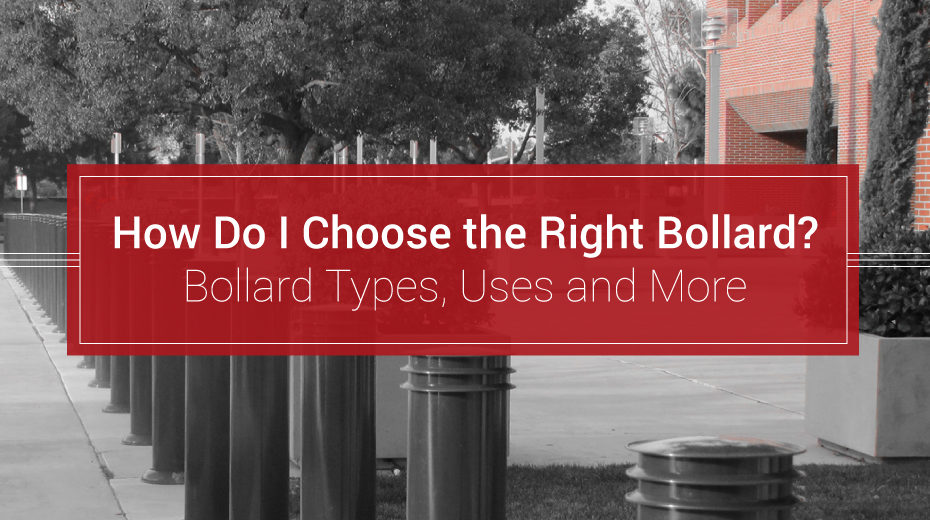Roads, public areas, churches, parking lots and other places are busy locations with strict rules to govern the general flow of traffic and ensure the safety of motorists and pedestrians. Driving can lead to drivers heading in the wrong direction or through areas not meant for vehicles. That’s where an access control and safety device like a bollard can be helpful.
A bollard is a short post that’s embedded in a sidewalk, parking lot, street, or other similar surfaces. The purpose of a bollard is to form a protective barrier that keeps cars where they need to be and safeguards pedestrians and businesses. It’s important to know which type of bollard best suits your needs and purposes.
To help you figure that out, we’ve put together a quick guide on the different types of bollards available and their intended uses and benefits.

Types of Bollards
Bollards come in a wide range of types and varieties, all of which have specific uses and offer unique benefits. You will want to consider the various types to choose the best bollard for your business and its needs.
1. Fixed Bollards
You might also hear this type of bollard referred to as embedded or permanent. The key characteristic of this bollard variety is how it embeds securely into the ground or the concrete. This embedding typically gives the bollard a little extra strength and security.

Fixed bollards use the same types of materials as other bollards, such as concrete, steel, or occasionally wood. However, the strength of the ground where you install it also plays a crucial role in its stability. For example, a steel post buried in concrete will be much stronger than a wooden post that’s only embedded in the sand. The difference in material also influences whether the bollard is actually a safety device or for decorative purposes.
This type of bollard is a practical solution for permanent layouts where there is no need to vary access. With greater embedment depths, fixed bollards are best for thick and secure foundational structures — if you’re considering a surface like a parking lot or access drive, this type of bollard may be the simplest, most cost-effective choice.
2. Automatic Bollards
Also known as rising or telescopic bollards, automatic bollards are retractable bollards that can rise out of the ground to block traffic and withdraw back into the ground to allow traffic to pass. Most extend to their full height in a matter of seconds, making them an efficient, flexible way to manage traffic and keep pedestrians safe.
You can control automatic bollards pneumatically, hydraulically, or electrically. This selection is often dependent on site-specific applications and uses. These bollards typically use carbon steel or stainless steel and are available in a variety of different finishes. Additionally, they install below grade and require regular maintenance.
Primary Uses for Automatic Bollards
These are ideal for situations where the flow of traffic varies often, and entry and exit might change at a moment’s notice. One example of a practical application for automatic bollards might be a parking garage or parking lot. They’re also perfect for use at the entrance to museums, zoos, or other public facilities where staff might restrict admittance after a certain hour.
3. Decorative Bollards
The designs of decorative bollards add aesthetic appeal to a sidewalk or building front. You can still use them to guide traffic and mark areas that vehicles should not access. However, decorative bollards aren’t intended for heavy-duty use and are not designed to stop cars or other vehicles. Because of this, decorative bollards are perfect for places where aesthetic is key and where heavy-impact bollards are not necessary.
While decorative bollards aren’t usually as durable as fixed bollards, they’re highly customizable. You can choose from a wide variety of materials such as iron or aluminum and can customize them to fit almost any architectural style. Whether you want to match the style of a 100-year-old mansion or a modern office building, there’s no limit to what these bollards can look like.
An architect or engineer can place these bollards anywhere they feel they will add aesthetic value and meet the project’s safety requirements. You can place decorative bollards along curbs, in front of buildings, or along walkways to help guide pedestrians. Additionally, you can use decorative bollards as a sleeve to go over a safety or security-grade bollard. With decorative bollards more than any other type of bollard, there’s a high level of flexibility.
4. Lighted Bollards
Lighted bollards perform various functions and can come in several styles. They can be retractable, fixed, embedded, or surface mounted. The uniting feature of these types of bollards is that they’re all equipped with lights, which adds a great safety and aesthetic element.
These bollards most commonly use aluminum or stainless steel, though other options are available. The light source itself may vary in color and intensity, allowing architects options when creating a certain design aesthetic. Design styles for lighted bollards can be more basic and utilitarian, or more detailed and decorative.

Common Uses for Lighted Bollards
Some common uses for lighted bollards are in landscaping, such as helping guide pedestrians along a path or in courtyards, plazas, and along streetscapes. They can be used anyplace that’s likely to experience a fair amount of traffic after dark, and where extra light would be helpful.
5. Manual Bollards
Manual bollards are very similar to automatic bollards. Like automatic bollards, manual bollards can retract into the ground to allow access to a space that you might want to restrict access to sometimes. The difference between manual and automatic bollards, however, is the way in which manual bollards perform retraction.
Automatic bollards have a mechanized retraction process, operating via a hydraulic, pneumatic, or electric method. A security guard, parking lot attendant, or other individual presses a button or a remote to operate them. For manual bollards, someone needs to complete this process by hand. You can choose from assisted and non-assisted models depending on the size and weight of the manual bollard.
Manual bollards typically come in stainless steel or carbon steel, and with a variety of options for finishes, so you can customize the look you want. Because manual bollards require more of a process to retract, we recommend using these for basic access control applications and situations where the need to restrict traffic doesn’t change on a very frequent basis or the need for remote operation is not necessary.
6. Removable Bollards
Removable bollards operate by the same basic principle as retractable bollards, where you need to change when to deny and grant access to areas. They come in an assortment of materials and finishes, so you can customize them to match the surrounding area where you install them. These types of bollards use a locking device to secure them in place, which you can take away to remove the entire bollard.
Locking options include pad-lockable or internal locking. Industrial businesses and settings tend to use pad-lockable removable bollards, while internal locking bollards allow the user to lock and unlock the bollard without having to reach down to the base of the bollard. This provides both a streamlined aesthetic as well as a more functional design in conditions where snow or other matter may collect at the base and inhibit padlock use.
There’s a high level of flexibility with these removable bollards, and they come in a range of different styles. This includes options for variation in the bollard itself, as well as the bollard head.
As in the case of the automatic and manual bollard, these removable bollards are appropriate for situations where access privileges need to change occasionally, but not too frequently. Examples include government facilities and public buildings, parking garages, city streets and other restricted access areas.
Factors to Consider When Choosing a Bollard
As you explore your options, consider all factors to choose the best bollard for your project. When you carefully think about the features you will need, you can ensure you find the right fit.
Material
You can design the best bollards for your projects by creating functional structures that match the aesthetic of their surroundings. For example, stainless steel can fit specific styles and offer a long lifespan sustainable in all climates, while aluminum is a good option for preventing rust.
Also, different materials determine if the bollard you choose is suitable as a safety device or solely for decoration.
Functionality
To determine the best design for your bollards, you should consider how they will function in their environment and their overall purpose. Bollards can provide various services, like managing traffic or blocking off pedestrian areas. Additionally, you should consider any unique features you may need to meet different functions, like spaces for wheelchair accessibility or emergency responders.
Once you determine your bollard’s purpose, you can create designs that will meet their function.
Crash Rating
Experts estimate that vehicles crash into stores, restaurants, and other establishments 60 times each day, leading to 500 deaths and more than 4000 injuries a year. Because bollards aim to save lives, they need proper testing to ensure they meet required safety standards.
You can crash-test and rate your bollards using one of the four common standards, which can inform you about the protection level each type offers:
- Department of State: The DOS no longer provides ratings, but the system is still in use. In this system, bollards receive “K” ratings that refer to the impact speed a bollard can handle. For example, a K4 certification means the bollard can withstand a crash at 30 mph, while a K12 can handle 50 mph.
- Department of Defense: This rating standard refers to the level of penetration experienced by the vehicle upon the test crash. This rating is referred to with the letter “L.” For example, an L3 rating means the penetration was less than 3 inches. So, a rating of K4L3 would indicate a 30 mph crash only caused 3 inches or less of penetration.
- ASTM F 2656-07: This rating is an industry standard that measures statistics about the vehicle that was used to test the bollards. The vehicle is assigned a letter based on what type of vehicle it is, and a number to indicate how fast the vehicle was traveling.
- BSI PAS 68:2010: This rating is essentially the British version of the ASTM rating and operates similarly.
Design
Creating a unique design is essential for seamlessly fitting your bollards into the aesthetic of their surroundings. You can customize various elements like size, color, shape, and material to help them blend into their environment.
Additionally, each type of bollard offers its own design elements that add to its function and appearance. Each uses different materials to help it function at its best. When choosing between the types, you can use their requirements to help determine the design. A clear bollard design allows people see how these objects can assist them.
4 Common Industry Uses of Bollards
Based on the different types of bollards, it’s easy to assess their usefulness and applications across numerous venues. Here are some common industries that use bollards:
1. Government Uses for Bollards
Government buildings are an excellent place to install bollards. There are numerous ways that government contractors typically do this. You can use bollards in their standard application to provide guides around public walkways where you do not want vehicle access, such as areas around the national monuments in Washington, D.C.
From museums to public parks, government-owned areas also commonly use retractable bollards. In addition to allowing access only during specified times, contractors can strategically use bollards to help deter theft or other break-ins and meet the government-required level of security. You can also place lighted bollards around the grounds or sidewalks to provide extra light and further deter theft or vandalism by keeping areas well-lit at night.
2. Bollards on Education and University Campuses
Educational buildings often need bollards to protect students and pedestrians in areas where vehicles also require some access. Schools and universities are high-traffic areas where it’s critical that the traffic operates correctly, since there are so many pedestrians milling within the vicinity. With students driving around, school buses trying to maneuver and parents waiting to pick up their children, there are many areas where bollards can improve safety.
In this setting, you can use bollards to mark the edges of the parking lot. You can even place them at the edges of walkways to ensure no one accidentally drives up onto the sidewalk or walkway and hits a student. By installing bollards in strategic locations, drivers will have a better idea of where they can drive their vehicles and will be less likely to drive in the wrong places and potentially endanger students or staff.
3. Why Businesses Need Bollards
In addition to businesses using bollards in their standard landscaping and sidewalk applications, they can also use them to provide extra light around the premises at night. This might be particularly important if the business is in a somewhat isolated location without a lot of light from neighboring businesses.

Businesses also might find it helpful to block off certain areas using bollards. For example, if trucks always come in to deliver shipments to one area of the parking lot, but cars are typically blocking this area, it might be helpful to use bollards to block this off so trucks can better access it. Since shipments typically come at designated times, removable or retractable bollards are a great option in this case, since access must only be restricted during certain times.
4. Bollards at Restaurants and Storefronts
Restaurants can use bollards on the sidewalks around their building to ensure cars don’t accidentally drive up onto the sidewalk, or worse yet accidentally drive into their restaurant building. When designing the layout of the building and parking lot, architects can use bollards to mark off the drive-through lane. Additionally, restaurants that offer outdoor seating areas would benefit from the use of bollards to enhance safety for their customers and also add a nice aesthetic to their outdoor atmosphere.
Storefronts such as those in strip malls, are highly susceptible to accidental or intentional incidents where cars crash into buildings, or worse, into pedestrians. These areas typically have nose-in parking with little room for error. Bollards create both a functional and aesthetic barrier to protect pedestrians both on the sidewalk and within a store. You can integrate signage into the bollard design to communicate information, or designate parking spots such as ADA.
Why Choose Blockaides to Purchase Bollards?
No matter what industry you belong to or what type of facility you’re looking to install a bollard in, Blockaides has both the experience and the product offering to provide the best solution for your project. We offer an assortment of different types of bollards, as well as a variety of materials and finishes. We also offer caps and other accessories so you can customize your bollards to fit your unique needs.
If you’re still unsure about which types of bollards are best for your property needs and applications, we’re available to help. Our team of safety and security professionals has extensive experience working with automatic bollards, decorative bollards, and everything in between. We can evaluate your property and its functional and aesthetic requirements to determine your needs. We’ll work with you to recommend the right solution for your unique situation.
We also back every product we sell with superior service and support. We partner with architects, project managers, contractors, and property owners to ensure every project meets our customers’ specifications. We’ll guide you through the entire process from beginning to end, including assessing the risks that impact your property and which types of bollards can provide the most reliable results. Once you’ve made your product selection, we’ll manage your installation project from start to finish.
Build Your Next Bollards With Blockaides
Bollards help provide excellent care and direction to pedestrians and motorists while matching surrounding structural aesthetics. The various types offer flexibility for function and design, so you can choose the best bollard for your project.
Blockaides has been helping businesses, organizations, and individuals meet their safety and security needs for more than a decade. When you partner with Blockaides, you can trust our team to provide high-quality products, exceptional service, and thought leadership that will protect your property and the people who use it every day.
Whatever type of bollard you choose, you can rest assured that our high-quality, American-made products will help promote safety, security, and even aesthetics at your site. Contact Blockaides today to explore our collection of bollards or request a custom quote.


